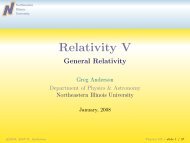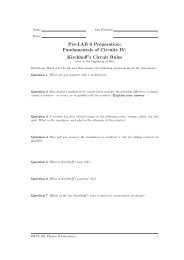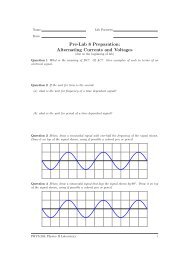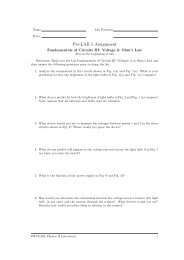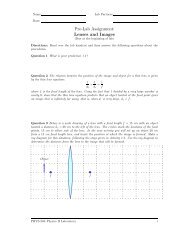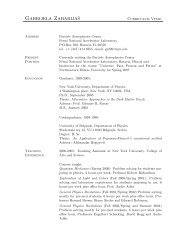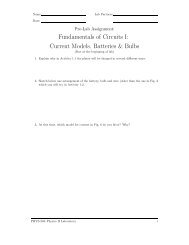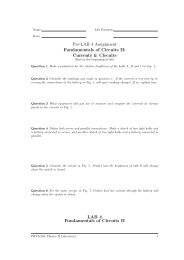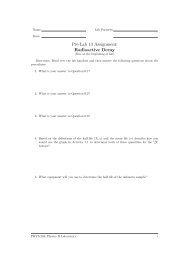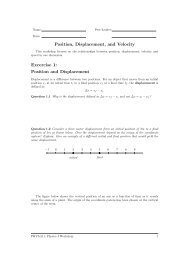Pre-Lab 7 Assignment: Capacitors and RC Circuits
Pre-Lab 7 Assignment: Capacitors and RC Circuits
Pre-Lab 7 Assignment: Capacitors and RC Circuits
- No tags were found...
Create successful ePaper yourself
Turn your PDF publications into a flip-book with our unique Google optimized e-Paper software.
<strong>Capacitors</strong> <strong>and</strong> <strong>RC</strong> <strong>Circuits</strong> v 0.3in electronic circuits that require storage of electrical energy (camera flash) or a specific timedependentfeature (e.g., intermittent wipers). Finally, although capacitors show some veryinteresting properties when connected in alternating current circuits, for this lab, we will limitourselves to the behavior of capacitors in direct current circuits like those you are familiar withfrom the lab exercises of the last few weeks. The circuit symbol for a capacitor is a pair of linesas shown in Fig. 2.CFigure 2: The circuit diagram symbol for a capacitor.Investigation 1:Capacitance, Area, <strong>and</strong> SeparationThe easiest method for transferring equal <strong>and</strong> opposite charges onto the plates of a capacitor(charging the capacitor) is to use a voltage source such as a battery or a power supply to createa potential difference between the two conducting plates. This potential difference causeselectrons to flow from one conductor (leaving positive charges behind) <strong>and</strong> onto the other untilthe potential difference between the two conductors is the same as that provided by the voltagesource. In general, the amount of charge transferred before this condition is met depends onthe size, shape, <strong>and</strong> location of the conductors relative to each other. The capacitance of thegiven capacitor is defined mathematically as the ratio of the magnitude of the charge, q, oneither one of the conductors to the voltage, V, applied across the two conductors so that:C = q/VIn words, capacitance is a measure of the amount of excess charge on either one of theconductors per unit potential difference between the plates.Draw on your underst<strong>and</strong>ing of potential difference to examine what might happen to thecharge as it flows in a circuit containing a parallel plate capacitor <strong>and</strong> a battery as shown inFig. 3. Such a thought experiment can help you develop an intuitive underst<strong>and</strong>ing for themeaning of capacitance. For a fixed voltage from a battery, the net charge found on eitherplate is proportional to the capacitance of the capacitor.Activity 1.1: <strong>Pre</strong>dicting the dependence of Capacitance on Area <strong>and</strong>SeparationTo visualize our circuit with a parallel plate capacitor, consider two identical metal plates ofarea A, separated by a non-conducting material that has a thickness d. They are connectedto a battery through a switch, as shown above. When the switch is open, there is no excesscharge on either plate. The switch is then closed completing the path between the battery <strong>and</strong>the capacitor.Question 1.1 What does the reasoning you pursued in your though experiment predict willhappen to the conducting plate attached to the negative terminal of the battery? What do youPHYS-204:Physics II <strong>Lab</strong>oratory 2




